

Revol_greffe.pdf. 3D Bio-Printing; Becoming Economically Feasible. An essential step toward printing living tissues. Cambridge, Mass. – February 19, 2014 – A new bioprinting method developed at the Harvard School of Engineering and Applied Sciences (SEAS) and the Wyss Institute for Biologically Inspired Engineering at Harvard University creates intricately patterned, three-dimensional tissue constructs with multiple types of cells and tiny blood vessels.
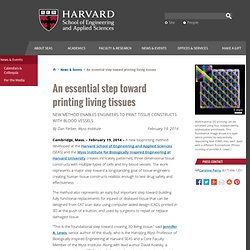
The work represents a major step toward a longstanding goal of tissue engineers: creating human tissue constructs realistic enough to test drug safety and effectiveness. The method also represents an early but important step toward building fully functional replacements for injured or diseased tissue that can be designed from CAT scan data using computer-aided design (CAD), printed in 3D at the push of a button, and used by surgeons to repair or replace damaged tissue. 3D Bioprinting of Vascularized, Heterogeneous Cell‐Laden Tissue Constructs. Bioprinting, Part 2 - The Ethical Conundrum. Bioprinting, Part 1 - The Promise and the Pitfalls Nearly 120,000 people in the United States are on the waiting list for an organ transplant that may save their lives, according to the American Transplant Foundation.
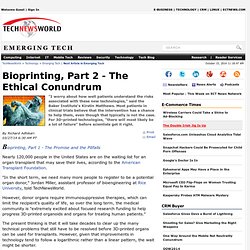
"In the short term, we need many more people to register to be a potential organ donor," Jordan Miller, assistant professor of bioengineering at Rice University, told TechNewsWorld. However, donor organs require immunosuppressive therapies, which can limit the recipient's quality of life, so over the long term, the medical community is "extremely excited about focused research funding to help progress 3D-printed organoids and organs for treating human patients.
" The present thinking is that it will take decades to clear up the many technical problems that still have to be resolved before 3D-printed organs can be used for transplants. However, given that improvements in technology tend to follow a logarithmic rather than a linear pattern, the wait might be shorter. Biology vs.
Phq164_48_dossier.pdf. Serimedis : la banque d'images de l'Inserm. Université Européenne de Bretagne. How Much Does Pharmaceutical Innovation Cost? A Look At 100 Companies. Pwc-pharma-2020-the-vision-french.pdf. PhRMA Profile 2013.pdf. 10-02-drugr-d.pdf. NME Output versus R&D Expense – Perhaps there is an explanation. A popular display of innovative productivity in the Biopharmaceutical Industry has been the plot of New Molecular Entitities (NMEs) versus Total R&D spend in the U.S., Figure 1.

Figure 1, NMEs , per year versus total R&D spend in Billions of Dollars (US$ 2008) (prior to 1984 first NCE Approvals) The response to this chart is straight forward. The number of NMEs per year was trending upward to 1996 but now in recent years then number appears to be going down. It would be good for NMEs per year to go up. Increased R&D spending has not helped. Many have responded to this chart.
Tollman et al. prepared a plot of NMEs over a six year period (2002-2008) per R&D spend over a six year period (1998-2004) for the top 25 biopharmaceutical companies to identify companies with the greatest number of NMEs with the lowest R&D investment. The increasing distance between NMEs and Pharma Spend in Figure 1 is often referred to as the “Innovation Gap”, e.g. Number of Companies. Bioprinting is a Multi-Billion Dollar Pharma Opportunity for 3D Printing. Organovo CEO Sheds Light on its Breakthrough Bioprinting Technology and Roadmap Ahead One of the most exciting and promising applications of 3D printing is bioprinting, the ability to manufacture living human tissue and possibly organs.

And one of the most exciting companies in this field is Organovo. Organovo (NYSE MKT: ONVO) designs and creates functional, three-dimensional human tissues for medical research and therapeutic applications. The Company collaborates with pharmaceutical and academic partners to develop human biological disease models in three dimensions. These 3D human tissues have the potential to accelerate the drug discovery process, enabling treatments to be developed faster and at lower cost.
Keith Murphy, Chairman and Chief Executive Officer of Organovo, spoke last week at the Inside 3D Printing conference in San Jose, CA. The 3D Bioprinting Revolution. By Suraj Kannan Perhaps no technology has grown as rapidly and promised so much in the last decade as 3D printing.
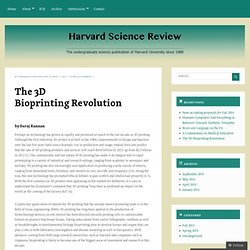
Although the first industrial 3D printer was built in the 1980s, improvements in design and function over the last five years have seen a dramatic rise in production and usage; indeed, forecasts predict that the sale of 3D printing products and services will reach $10.8 billion by 2021, up from $2.2 billion in 2012 (1). The customizable and fast nature of 3D printing has made it an integral tool in rapid prototyping in a variety of industrial and research settings, ranging from academic to aerospace and military. 3D printing has also increasingly seen application in producing a wide variety of objects, ranging from household tools, furniture, and utensils to cars, aircraft, and weaponry (2-4).
Along the way, this new technology has prompted ethical debates in gun control and intellectual property (4, 5). Bioprinting: A Customizable Bottom-Up Approach. 4066.pdf. Binder_wfu_0248D_10078.pdf. L’imprimante 3D révolutionne la médecine. C’en est bientôt fini des plâtres lourds et inesthétiques, sources d’inconfort et de démangeaisons.
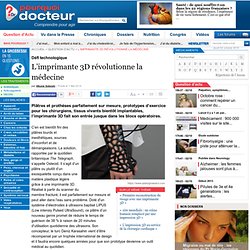
La solution, rapportée par le quotidien britannique The Telegraph, s’appelle Osteoid. Innovation à Bordeaux : la bio-impression laser. Bioprinting, Part 1: The Promise and the Pitfalls. A lire sur: By Richard Adhikari, TechNewsWorld , 03/26/14 6:26 AM PT The technical side of printing small-volume organs "may be achieved within the next two years," said Kevin Healy, chair of the department of bioengineering at the University of California at Berkeley.

However, the ability to develop vascularization of such organs is at least five years away. "The harder problem is to figure out what cells to use to avoid immune rejection. " Lauréat NETEXPLO 2014 - Eline KUIPERS et Ingmar VAN HENGEL pour SKINPRINT (The Netherlands) How Autodesk's Project Cyborg Will Revolutionize Synthetic Biology. Software is an extremely valuable tool with countless applications.
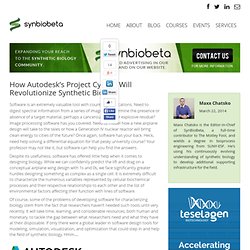
Need to digest spectral information from a series of images to determine the presence or absence of a target material, perhaps a cancerous tumor or explosive residue? Image processing software has you covered. Need to model how a new airplane design will take to the skies or how a Generation IV nuclear reactor will bring clean energy to cities of the future? Once again, software has your back. Can Autodesk and Organovo Bring Tissue Engineering to a Hospital Near You? (ADSK, ONVO) Tissue engineering has captured the imagination of mainstream media and investors alike.
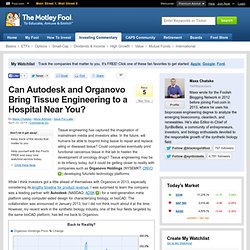
In the future, will humans be able to bioprint living tissue to repair and replace ailing or diseased tissue? Could companies eventually print functional cancerous tissue in the lab to hasten the development of oncology drugs? Tissue engineering may be in its infancy today, but it could be getting closer to reality with companies such as Organovo Holdings (NYSEMKT: ONVO ) developing futuristic technology platforms. While I think investors got a little ahead of themselves with Organovo in 2013, especially considering its lengthy timeline for product revenue, I was surprised to learn the company was a leading partner with Autodesk (NASDAQ: ADSK ) for a next-generation meta platform using computer-aided design for characterizing biology, or bioCAD.
The collaboration was announced in January 2013, but I did not think much about it at the time. Bio-impression: La création de tissus vivants grâce à une imprimante laser 3D, dans Votre santé m'intéresse – Science.iop.org/1758-5090/2/2/022001/pdf/1758-5090_2_2_022001.pdf. S1568558611000301. Bioprinted Human Tissue. L'incroyable essor du bioprinting. Une toute récente étude Research&Market le marché de l’impression 3D va doubler d’ici 2025, pour atteindre 7 milliards de dollars.

Ce n’est pas la prévision la plus optimiste mais elle est en ligne avec les autres études, mais ce qui peut surprendre le plus dans cette étude, c’est que les analystes estiment que sur ces 7 milliards, 3 seront générés par ce que l’on appelle le bioprinting. Harvard scientists 3D bioprint layered tissue with blood vessels. Feb.20, 2014 3D bioprinting, the process of creating human tissues through 3D printing, is in the early stages of development. But bioprinting will advance far faster than general understanding and acceptance of the ramifications of this technology, according to analyst firm Gartner. Scientists at the Harvard Wyss Institute for Biologically Inspired Engineering announced Wednesday that they have used multiple print heads and customized "inks" to create complex living tissue constructs, complete with tiny blood vessels.
The method represents an early but important step toward creating human tissue constructs realistic enough to test drug safety and effectiveness and building fully functional replacements for injured or diseased tissue. "Tissue engineers have been waiting for a method like this," said Don Ingber, M.D., Ph.D., Wyss Institute Founding Toward Printed Living Tissues: Harvard team 3D prints blood vessel-lined tissue Director. Video above: Building intricate structures.
The result. TeVido BioDevices develops 3D bioprinted skin grafts for breast reconstruction. Aug. 15, 2014 New advancements in 3D printing could already improve and save lives with reproducing human cells in laboratories. While companies like Organovo and Wake Forest Institute for Regenerative Medicine are on the path to use the technology to create blood vessels, skin tissue or human organs, another company, TeVido BioDevices is working on 3D printing skin grafts for patients.
Austin-based TeVido BioDevices is working to develop patent-pending technology, Cellatier to use 3D printers to reconstruct and print breast tissue specifically for breast cancer survivors. TeVido's first focus is on improvements in nipple reconstruction, a significant unmet need with currently limited options for women undergoing breast reconstruction post-mastectomy, said Laura Bosworth, CEO of TeVido BioDevices.
Comment fabriquer de la peau avec une imprimante 3D ? Quand l'imprimante façonne le vivant - 15 avril 2014. Une révolution à venir pour la recherche pharmaceutique et la médecine régénérative. Le bioprinting se développe encore et encore. Bioprinter @ Forgacslab. E are trying to build three dimensional tissue structures by a rapid prototyping method, the bioprinting. The biopaper in our setup is a biocompatible hydrogel (collagen, gelatin, hyaluronic acid, etc.), the ink particles consist of spherical cell aggregates containing about 60-80000 cells.
The bioprinter contains a 2D table and a Z assembly, on which the nozzles (housing the gel and aggregates) are mounted. Sir, Your Liver Is Ready: Behind the Scenes of Bioprinting. SAN DIEGO -– Say goodbye to donor lists and organ shortages. A biotech firm has created a printer that prints veins using a patients’ own cells.
The device could potentially create whole organs in the future. “Right now we’re really good at printing blood vessels,” says Ben Shepherd, senior research scientist at regenerative-medicine company Organovo. “We printed 10 this week. New Skin Printer Could Print You Some New Skin. Wake Forest's skin printer deposits cells directly on wounds to heal them faster. Healing your wounds quickly and safely may be as easy as filling an inkjet printer with your cells. Wake Forest’s Institute for Regenerative Medicine (WFIRM) and the Armed Forces Institute for Regenerative Medicine (AFIRM) have developed a skin printer that can deposit cells directly onto a wound to help it heal faster.
They recently presented the results of their latest experiments at the American College of Surgeons Clinical Congress (ACSCC) in Washington DC. Mice given topical wounds were able to heal in just three weeks when a new skin was printed onto the damaged area (compared to 5-6 with control groups). WFIRM and AFIRM also stated that the skin printer had been tested to see if it could print human cells, but that the next step forward would be experiments on pigs. Mouse wounds healed better and faster with the skin printer. Inkjet-like device 'prints' cells right over burns.
Researchers aim to 'print' human skin. Each cell type is placed in a vial, rather than in cartridges. The cells are then "printed" directly on the wound. A Myriad of Medical 3D Printing Applications on the Way. Marie Gethins May 2014 Decreasing cost and better access to 3D printing is fuelling a research explosion into using the technique for medical applications. While the technology has created impressive external cosmetic replacements such as ears and noses, research into internal devices constructed through 3D printing for hips, knees, elbows and jaws is on-going.
Perhaps even more exciting is the potential to construct products embedded with biological materials for regenerative purposes, a process known as bioprinting. Multiple applications of this process are being explored. In June 2012, researchers in Belgium used 3D printing to create a replacement titanium lower jaw. Researchers believe the same technique could be applied to hip, knee, elbow and shoulder prostheses, and even large portions of the skull. The idea is to use an implant or a conduit to facilitate the natural regeneration process.
De la peau fabriquée par une imprimante jet d'encre modifiée ! Des chercheurs américains ont réussi à fabriquer une matrice de peau avec une d'imprimante à jet d'encre légèrement modifiée ! Cette matrice a été "imprimée" directement sur la brûlure du dos d'une souris, qui a cicatrisé beaucoup mieux et beaucoup plus vite que les souris témoin. Www.pitt.edu/~ndk18/engtrend.html. A burn is an injury that damages the skin and can be caused by heat, chemicals, electricity, friction, or radiation. A lot of these types of injury require immediate medical care. In the United States alone, 450,000 citizens received medical treatment for a burn related injury in the past year and out of those, nearly 3,400 died as result of their injury [1]. 3D CELL BIOPRINTING FOR REGENERATIVE MEDICINE RESEARCH AND THERAPIES * Une peau pigmentée grâce aux cellules souches.
23 août 2011 Ces travaux, publiés dans la revue PNAS, sont disponibles en ligne. Cancer-de-la-peau-autre-que-le-melanome-RZ7Z2fPUhBYp-6679.pdf. Le vivant s’imprime en 3 D - Pharmacie / Biotechnologies. Avancée dans l’impression 3D de tissu humain [video] Bioprinting for stem cell research. Bioprinters: Printing a bit of me. Says Uses of 3D Printing Will Ignite Major Debate on Ethics and Regulation. Bioprinting by Mike Ellison on Prezi. Tevido Biodevices développe des greffes de peau bio-imprimées en 3D pour la reconstruction mammaire. Harvard Engineers 3D 'Bioprint' Layered Tissue with Blood Vessel Networks [VIDEOS] : Tech. Tissue Engineered Skin Substitutes Created by Laser-Assisted Bioprinting Form Skin-Like Structures in the Dorsal Skin Fold Chamber in Mice. L'ingénierie tissulaire reconstruit l'être humain. [Infographie] Bioprinting : imprimer des tissus humains.
Files/Denis_Dufrane.pdf. Quand l'imprimante façonne le vivant - 15 avril 2014. Organovo Un espoir pour des millions de personnes - Biotech Trade. Organovo. La bio-impression d'organe au secours de la médecine régénératrice. Bioprintig : mode d'emploi pour construire son imprimante à cellules. Bioprinting, l’impression du vivant Business Herald. Ceci est une révolution ... l'impression 3D. Www.worldscientific.com/doi/pdf/10.1142/S1568558611000301?src=recsys. La longue marche de la médecine régénérative. L’avancée des progrès de la médecine régénérative. Www.sante-2025.org/wp-content/uploads/2010/03/Sante_2025-fiche-531.pdf. Bioprinting: Creative disruptive technology. Markets in everything: 3-D ‘bio-printing,’ a very promising blockbuster medical development. Etat des lieux de l'économie numérique en 2013Incubateur Belle de Mai. Bioprinting in 3D.
Technologies du futur - Le blog de Françoise. Www.sirona.com/ecomaXL/get_blob.php?name=RevuedePresse-01.14.pdf. Un pas de plus vers le « bioprinting », l'impression de tissus humains. Bioprinting : Création de tissus humains en 3D : Temps de lecture : 2 min 6 s - François Gros. Rapid Prototyping That Really Gets Under Your Skin. 3D printed skin available within 5 years, say researchers. Bioprinting: a regenerative revolution? 3D Printing For New Tissues And Organs. New applications of 3D printing will emerge, a US$7bn market by 2025. Bioprinting. How 3-D Printing Body Parts Will Revolutionize Medicine. Bioprinting: From Concept to Reality. Harvard scientists 3D bioprint layered tissue with blood vessels. Impression 3D: perspectives et enjeux. Un pas de plus vers l'Homme bionique grâce à l'impression 3D.
Implications médicales de l'impression 3D. Un pas de plus vers le « bioprinting », l'impression de tissus humains. Bioprinting, l’impression du vivant Business Herald. Bioprinting : imprimer du vivant ne relève plus de la science-fiction. Le vivant s’imprime en 3 D - Pharmacie / Biotechnologies. Bio Printing.